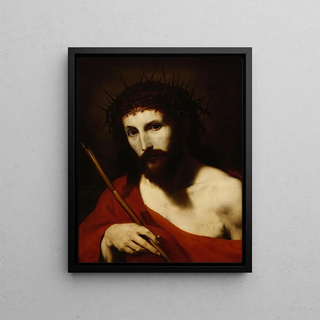Art print | Voici l'homme - Jusepe de Ribera


View from behind

Frame (optional)
Reproduction Here is the man - Jusepe de Ribera – Captivating introduction
In the fascinating universe of baroque painting, the art print "Here is the man" by Jusepe de Ribera stands out for its evocative power and striking realism. This iconic piece, which embodies both the technical mastery of the artist and a profound reflection on the human condition, captures the eye and evokes emotion. Through this art print, the viewer is invited to delve into a world where light and shadow meet, revealing hidden truths behind faces and gestures. Ribera's work is an invitation to contemplate human nature in all its complexity—a journey that is both aesthetic and philosophical.
Style and uniqueness of the work
"Here is the man" is a piece that perfectly illustrates Ribera's unique style, characterized by dramatic chiaroscuro and meticulous attention to detail. The artist manages to capture the very essence of his subjects, endowing them with rare psychological depth. The pronounced features, accentuated shadows, and earthy colors create an atmosphere that is both realistic and mystical. Ribera does not merely depict a face; he explores its emotions, doubts, and sufferings. This introspective approach gives the work an almost spiritual dimension, transcending the simple portrait to become a reflection on humanity. The subject's posture, imbued with dignity and vulnerability, engages the viewer and invites active contemplation—a search for meaning beyond appearances.
The artist and his influence
Jusepe de Ribera, born in Spain and having spent much of his life in Italy, is one of the masters of Spanish baroque. Influenced by Caravaggio, he developed a style that is uniquely his own, blending realism and dramatization. His ability to handle religious and secular themes with rare emotional intensity marked his era and continues to inspire many artists. Ribera not only contributed to the evolution of baroque painting but also left an indelible mark on the development of art in Europe. His works, often populated with human figures and scenes of daily life, question the notions

Matte finish

View from behind

Frame (optional)
Reproduction Here is the man - Jusepe de Ribera – Captivating introduction
In the fascinating universe of baroque painting, the art print "Here is the man" by Jusepe de Ribera stands out for its evocative power and striking realism. This iconic piece, which embodies both the technical mastery of the artist and a profound reflection on the human condition, captures the eye and evokes emotion. Through this art print, the viewer is invited to delve into a world where light and shadow meet, revealing hidden truths behind faces and gestures. Ribera's work is an invitation to contemplate human nature in all its complexity—a journey that is both aesthetic and philosophical.
Style and uniqueness of the work
"Here is the man" is a piece that perfectly illustrates Ribera's unique style, characterized by dramatic chiaroscuro and meticulous attention to detail. The artist manages to capture the very essence of his subjects, endowing them with rare psychological depth. The pronounced features, accentuated shadows, and earthy colors create an atmosphere that is both realistic and mystical. Ribera does not merely depict a face; he explores its emotions, doubts, and sufferings. This introspective approach gives the work an almost spiritual dimension, transcending the simple portrait to become a reflection on humanity. The subject's posture, imbued with dignity and vulnerability, engages the viewer and invites active contemplation—a search for meaning beyond appearances.
The artist and his influence
Jusepe de Ribera, born in Spain and having spent much of his life in Italy, is one of the masters of Spanish baroque. Influenced by Caravaggio, he developed a style that is uniquely his own, blending realism and dramatization. His ability to handle religious and secular themes with rare emotional intensity marked his era and continues to inspire many artists. Ribera not only contributed to the evolution of baroque painting but also left an indelible mark on the development of art in Europe. His works, often populated with human figures and scenes of daily life, question the notions






